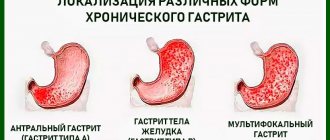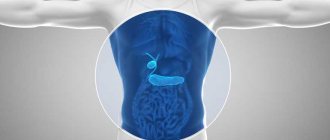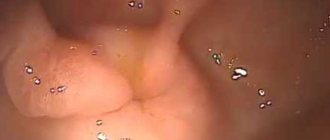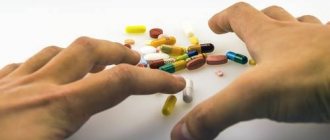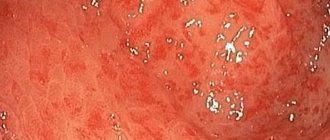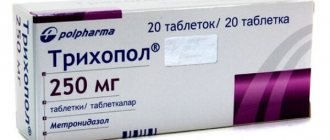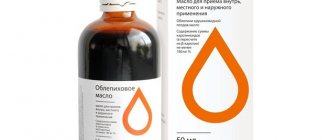Characteristics of the disease
Atrophic gastritis is a disease that affects the secretory glands.
Atrophic gastritis is a disease in which the cells of the secretory glands located in the walls of the stomach are damaged, which subsequently atrophy: they lose the ability to function and produce components of gastric juice.
The glands begin to produce mucus instead of the components of gastric juice. The focus of antral atrophic gastritis is the lowest located section of the stomach, which passes into the intestine. This section is called the antrum.
The cells of the stomach walls, like all other cells of the body, are constantly functioning. Their regeneration, differentiation, functional load, natural death and further renewal occur under the influence of hormonal, enzymatic, and immune factors. The functioning of cells can be disrupted under the influence of unfavorable factors:
- Acid-fast microorganisms
- Autoimmune processes of the body
When the walls of the stomach are subjected to bacterial attack, the mucous membrane loses its protective functions, the acid balance of the walls changes, and Helicobacter gastritis develops. The bacteria Helicobacter pylori creates conditions for the development of atrophic gastritis. Atrophy of the gastric region or the entire stomach occurs. Atrophied areas appear on the mucosa, the glands do not perform their function and turn into epithelial tissue. The mucous membrane stops producing hydrochloric acid and pepsin, becomes thinner, and the secretion of gastric juice decreases.
Under the influence of autoimmune processes, cells with impaired functioning begin to produce their own kind; they are not able to develop and carry out secretory function.
Features of antral gastritis
This form refers to chronic inflammatory processes located directly on the gastric mucosa. If we talk specifically about the location, the disease affects the very lower part of the stomach, where there is a small “valve” that connects the organ with the duodenum.
For a long time, doctors believed that the occurrence of this form of gastritis was associated solely with alcohol abuse, uncontrolled consumption of unhealthy foods or smoking. However, modern medicine has established that the main causative agent of antral gastritis is the bacterium Helicobacter pylori. It secretes special enzymes that greatly harm the stomach and provoke it to produce acid. The constant presence of an irritant causes the appearance of inflammatory processes on the mucous surface of the organ.
How dangerous is the disease?
Atrophy of the mucosa provokes the development of dysbacteriosis.
Antral atrophic gastritis occurs in three phases:
- Antral subatrophic gastritis - the beginning of atrophic changes that have not ended
- Antral atrophic gastritis
- Chronic antral atrophic gastritis
Tissue death begins with parietal cells, which are predominantly located in the antrum of the stomach. When the process of cell atrophy accelerates, the production of digestive enzymes (hydrochloric acid, pepsinogen, gastromucoprotein) is significantly reduced, so the digestive process is reduced. A lack of gastromucoprotein, which is responsible for the absorption of vitamin B 12, provokes the development of anemia.
The antrum occupies a third of the stomach; under normal conditions, the acidity in this area is low. If the glands of the antrum of the stomach do not function, the stomach cannot cope with the digestive function, food enters the intestines in a half-processed form. As a result, the intestines are affected: its walls become irritated and inflamed, and duodenitis develops.
Types of antral gastritis
This form of gastritis has several types, which differ in their symptoms:
• chronic - it is characterized by constant relapses. Most often, this type is completely asymptomatic and makes itself felt only in case of exacerbation; • erosive - with this type, the inner lining of the stomach is severely damaged. Due to increased acidity, many small wounds appear on it, which can cause severe pain to the patient; • superficial - it is expressed weakly, but evidence of its presence is constant heartburn, heaviness after eating and sour belching; • focal - in this case, inflammation is local in nature. If left untreated, they lead to atrophy of the gastric glands, which interferes with the normal absorption and digestion of food.
Signs of the disease
Loss of appetite is the main symptom of gastritis.
The manifestation of symptoms of the disease depends on the degree of the atrophic process. Atrophic gastritis is divided according to intensity:
- Pronounced
- Moderately expressed
- Atrophic-hyperplastic
The main symptoms of the disease include:
- Heaviness in the stomach
- Dull pain in the abdomen
- Belching with a rotten smell
- Dry mouth
- Bitter taste in mouth
- Weight loss
- Loss of appetite
- Diarrhea and constipation alternately
- Smooth tongue with white coating
Due to a lack of vitamins and nutrients, the following symptoms are observed:
- Decreased vision
- Bleeding gums
- Brittle nails
- Hair loss
- Dry and pale skin
- Weakness, dizziness, chills after eating
- Purulent skin lesions
- Frequent colds
- Risk factors
In a healthy person, the mucous membrane represents a damage-resistant, durable defense of the stomach walls; this protection is much more powerful than that of skin cells, but under the influence of certain factors it is reduced. Factors causing weakening of the mucosa:
- Diseases of the gastrointestinal tract
- Weakened immune system
- Great physical activity
- Occupational hazard
- Overwork
- Stress
- Hereditary diseases
- Consequences of the disease
Atrophic gastritis provokes the development of a cancerous tumor; the lower the acidity of gastric juice, the higher the risk. The beginning of degeneration is difficult to determine; in the initial stages, cancer does not make itself known. Therefore, it is important to begin treatment of atrophic gastritis as early as possible, even at the stage of subatrophic gastritis. Severe atrophy of the stomach walls is recognized as a precancerous disease.
Diet
An important part of treatment is diet. Nutrition should be prescribed exclusively by the attending physician. Food is selected depending on the severity of the disease and helps the stomach to fully recover.
First, you will have to give up large portions of food. It is better to adhere to the principle of fractional nutrition - eat often, but little. The menu must include:
• low-fat soups, • boiled or baked vegetables; • steamed poultry; • jelly, compotes, weak tea, low-fat milk.
During the diet you will have to forget about:
• spicy food; • pickles; • berries and fruits; • various sauces; • coffee and strong tea; • dairy products with high fat content.
Treatment
One of the treatment options is taking antibiotics.
For atrophic gastritis of the antrum of the stomach, medication, physiotherapy and diet are used. Surgical intervention is resorted to only when tumors occur in the stomach. Drug therapy includes:
- Treatment with antibiotics (at least three drugs)
- Reducing gastric secretion with proton pump inhibitors
- Creating a protective shell on the walls of the stomach using bismuth-containing drugs
- Nutrition and restoration of the gastric mucosa with gastroprotectors
- Stimulation of food movement through the digestive tract using prokinetics
Replacement therapy is carried out to introduce missing substances into the body:
- Enzymes
- Hydrochloric acid preparations
- Vitamin B12
- Physiotherapeutic treatment:
- Electrophoresis
- Warmth on the lower abdomen
- Electrotherapy
- Magnetotherapy
Diet
- 5-6 meals a day in small portions
- Avoiding spicy, fried and fatty foods
- Avoiding alcohol and smoking
- The temperature of the food should be 50 o
- Include porridges, low-fat broths, jelly
How to treat antral gastritis
In order to prescribe correct and accurate treatment, the doctor will conduct a series of examinations, thanks to which you can accurately determine the cause, degree and, of course, form of gastritis. To do this, the following procedures are required:
• general examination and recording of patient complaints; • Ultrasound of the abdominal cavity; • gastroscopy; • taking tissue samples for biopsy; • determination of alkaline balance in the organ; • general blood analysis; • urine and feces analysis; • breath test for the presence of Helicobacter bacteria.
After that, the gastroenterologist, based on the results of the examinations, will decide which treatment will be optimal. For example, acute and chronic forms are treated completely differently, but the approach in any case should be comprehensive: a strict diet, adherence to a daily routine, taking medications and giving up bad habits.
As for the treatment of each form, the acute form is often accompanied by the appearance of erosions and internal bleeding. Therefore, some patients are indicated for inpatient treatment under the close attention of doctors. It is worth noting that the treatment of this form of the disease is very long and difficult, since the erosions are completely healed only after one and a half to two weeks.
Very often, specialists prescribe drug treatment with a complex of strong antibiotics for two weeks. They help fight Helicobacter and rid the stomach of its harmful effects. Then the mucous surface of the organ is restored with the help of antacids and proton pump inhibitors. These medications can not only relieve pain and neutralize large amounts of stomach acid, but also heal the remaining damage from gastritis.
The dosage and duration of treatment are prescribed exclusively by a gastroenterologist. And if you follow all the rules of treatment, you will soon be able to forget about gastritis.
Diagnostics
As with any other form of the disease, the most significant study for a non-atrophic process is FGDS with biopsy. During gastroscopy, you can see a reddish, swollen gastric mucosa, sometimes with small hemorrhages and erosions. Microscopically, preserved glands, parietal cells, and desquamated epithelium are revealed. The gastric mucosa is infiltrated with inflammatory immune cells (neutrophils, lymphocytes, monocytes).
When collecting histological material, the presence of Helicobacter pylori is also determined. Another - simpler, but less accurate - way to diagnose Helicobacter pylori infection is a breath test.
To exclude an ulcer, an X-ray of the stomach with barium contrast is sometimes performed. This technique is used only if gastroscopy cannot be performed. The ulcer looks like a depression, a “niche” in the gastric mucosa; gastritis is not visible on x-rays.
To clarify the volume of hydrochloric acid produced, the patient is prescribed pH testing. It shows the background (basal) level of HCl secretion and secretion after hormonal stimulation. The pH level either remains at normal values, or a moderate increase is observed.
Prevention
To extend the remission period you need to:
- stop smoking and drinking alcohol;
- establish a diet;
- adhere to recommended dietary restrictions;
- conduct courses of preventive treatment with vitamins in spring and autumn;
- Do fibrogastroscopy at least once a year.
Antral gastritis is a chronic disease, but with timely treatment it can be managed without serious consequences. Any manifestation of symptoms requires examination and consultation with a doctor.
Folk remedies
Traditional medicine can be a good help for drug therapy in restoring tissue and normalizing stomach functions, but if used correctly. It is best if folk remedies are agreed upon with your doctor. The following folk methods are widely used:
- Potato juice is taken 3 times a day before meals, and the dose is gradually increased from 25 ml to 100 ml, the course of treatment is 15 days.
- Sea buckthorn in the form of berries.
- Sea buckthorn oil is taken 3 times a day, 1 tbsp. l.
- Cabbage juice is taken 100 ml 3 times a day for 20-30 days.
- A mixture of flaxseeds with water (2 tablespoons per 0.5 liters of water), consumed 60-70 ml 3-4 times a day before meals for 15-25 days.
- Honey can be used separately or added to any composition.
- Sea buckthorn infusion: the berries are poured with boiling water (in a ratio of 1:5) and infused for 2 hours, honey is added to the cooled composition, and drunk in a volume of 0.8-1 liters during the day.
Erosive gastritis is a fairly dangerous disease and is one of the most severe types of gastritis. The effectiveness of treatment largely depends on the timely initiation of treatment. At the first signs, you should consult a doctor, since self-diagnosis is very difficult due to the similarity of symptoms with many other diseases.
Causes
The occurrence of mucosal atrophy is explained by external and internal reasons. External influence is provided by:
- violations of the regime and nutritional value of food intake (long periods of hunger, abnormal diets, passion for fatty meat foods, lack of sufficient amounts of vegetables and fruits);
- the influence of alcohol and nicotine;
- professional and household poisoning with toxic acids, alkalis, salts of heavy metals;
- sensitivity to drugs.
Internal causes are combinations of unfavorable factors, which include:
- infection with Helicobacter;
- the presence in a person of severe nervous and endocrine disorders that disrupt the processes of regulation of the restoration of the gastric epithelium;
- deterioration of tissue nutrition due to damage to the vascular network by atherosclerosis, the formation of venous stagnation with thrombosis;
- unfavorable heredity.
The above reasons are significant for any form of atrophy. In order for a hyperplastic process to appear against this background, the following are additionally required:
- autoimmune disorders (pernicious anemia);
- infection with cytomegalovirus against the background of high activity of Helicobacter pylori;
- gross changes in the regulation of mucus production by glands, especially in the fundus of the stomach;
- eosinophilia in peripheral blood caused by parasitic diseases (ascariasis, anisakiasis, filariasis);
- a certain mutation at the genetic level, it was revealed that unfavorable heredity is formed due to disturbances in the normal structure of the β-catenin genes, the MEN1 tumor suppressor in Zollinger-Ellison syndrome (a tumor of the pancreatic islets, accompanied by increased production of gastrin and activation of the secretion of hydrochloric acid in the stomach) ;
- congenital anomalies of the stomach and its tissues (as an example, Cronkhite-Canada syndrome - polyposis of the entire gastrointestinal tract with the formation of cysts inside the growths, necrotization of polyps).
Anisakidosis is common among marine life; humans become infected through eating salted fish or preparing fresh fish dishes, which is accompanied by eosinophilia.
Forecast
The prognosis of hyperplastic atrophic gastritis is determined by the form of the disease. It is unfavorable for healing. The patient manages to live long enough if he follows the doctor’s recommendations. You will have to follow a diet all your life, take maintenance medications, and undergo examinations.
It is impossible to predict in advance how dangerous the transformation into a tumor is. The given examples indicate a probability, but do not mean a mandatory outcome. The many-sided nature of hyperplastic atrophic gastritis and moderate clinical manifestations pose the task of conducting mass preventive studies during clinical examination of the population.


